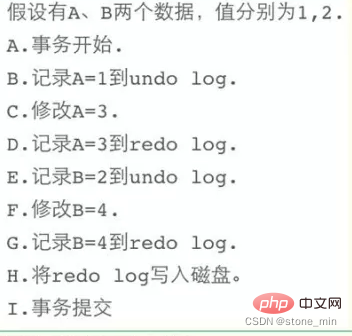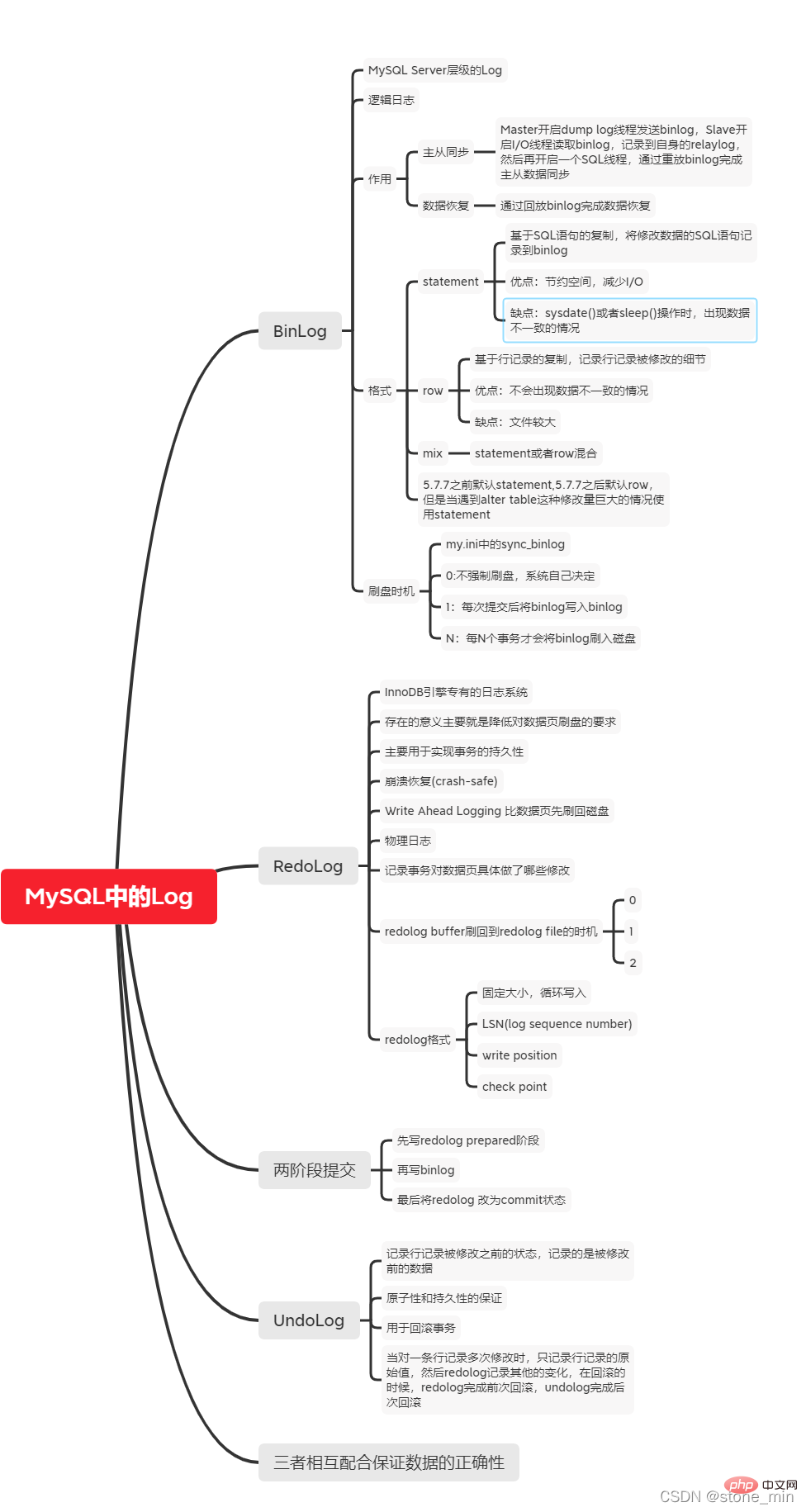 Database
Database
 Mysql Tutorial
Mysql Tutorial
 Completely master MySQL's three major logs: binlog, redo log and undo log
Completely master MySQL's three major logs: binlog, redo log and undo log
Completely master MySQL's three major logs: binlog, redo log and undo log
This article brings you relevant knowledge about mysql logs. What we need to focus on is the binary log (binlog) and transaction log (including redo log and undo log). I hope it will be helpful to everyone.

1, binlog
binlog is used to record write operations (excluding queries) information performed by the database and is saved in binary form in the disk. Binlog is the logical log of mysql and is recorded by the server layer. Mysql databases using any storage engine will record binlog logs.
- Logical log: can be simply understood as a sql statement;
- Physical log: The data in MySQL is stored in the data page, and the physical log records the data on the data page. Change; insert code snippet here
Binlog is written by appending. You can set the size of each binlog file through the max_binlog_size parameter. When the file size reaches the given value, it will be generated New file to save logs.
binlog usage scenarios
Project In actual applications, there are two main usage scenarios for binlog, namely master-slave replication and data recovery.
- Master-slave replication: Enable binlog on the Master side, and then send the binlog to each Slave side. The Slave side replays the binlog to achieve master-slave data consistency.
- Data recovery: Recover data by using the mysqlbinlog tool.
MySQL master-slave synchronization principle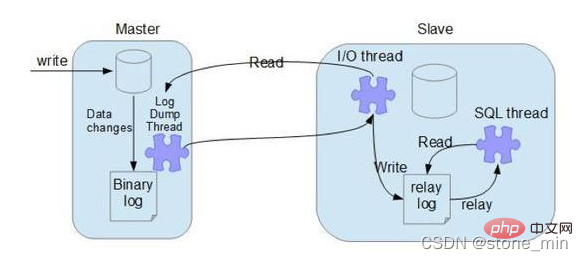
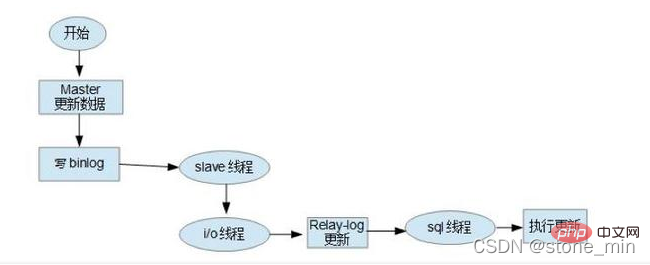
- Master node binlog dump thread
When the slave node connects When the master node is used, the master node will create a log dump thread to send the contents of the binlog. When reading operations in the binlog, this thread will lock the binlog on the master node. When the read is completed, the lock will be released even before it is sent to the slave node; - Slave node I/O Thread
After executing the start slave command on the slave node, the slave node will create an I/O thread to connect to the master node and request the updated binlog in the master library. After the I/O thread receives the update from the master node binlog dump process, it saves it in the local relaylog; - Slave node SQL thread
The SQL thread is responsible for reading the content in the relaylog and parsing it into specific Operation and execution, ultimately ensuring the consistency of master-slave data;
MySQL database master-slave synchronization principle
binlog content
As mentioned above, binlog is a A logical log can be simply understood as a SQL statement, but in fact it also contains the reverse logic of the executed SQL statement. delete corresponds to delete itself and the reverse insert information; update contains information about the data rows before and after the corresponding update is executed; insert contains its own insert and corresponding delete information.
binlog format
There are three binlog formats, namely statement, row and mixed. Before MySQL 5.7.7, statement was used by default, and after MySQL 5.7.7, row was used by default. The format of the log can be modified through binlog-format in the my.ini configuration file.
(1) Statement: Statement-based replication (SBR) based on SQL statements. Each SQL statement that modifies data will be recorded in the binlog.
- Advantages: No need to specifically record changes in a certain row, saving space, reducing IO, and improving performance;
- Disadvantages: When performing operations such as sysdate() or sleep() , which may lead to inconsistency between master and slave data;
(2) row: row-based replication (RBR), which does not record SQL statement context-related information, but records which Details of the record being modified.
- Advantages: The details of each row record modification are recorded in very detail, so there will be no situation where the data cannot be copied correctly;
- Disadvantages: Because each row is recorded in great detail Record the details of the modification, which will generate a lot of log content. Assume that there is an update statement and many records are modified. Each modified record will be recorded in the binlog. In particular, for the alter table operation, due to changes in the table structure, each row of records will change, resulting in a sudden increase in log volume;
(3)mixed: According to the above, statement and row Each has its own advantages and disadvantages, so the mixed version emerged to mix the two. Under normal circumstances, the statement format is used for saving. When the statement cannot be solved, switch to row format for saving.
In particular, as mentioned above, the new version (after MySQL 5.7.7) uses the row format by default. The row here has also been optimized accordingly. When encountering the alter table operation, the statement format is used for recording. The rest Operations still use row format.
binlog flushing timing
For the InnoDB storage engine, the binlog will only be recorded when the transaction is submitted. At this time, the record is still in the memory, and MySQL passes sync_binlog controls the flushing timing of binlog. The value range is 0-N:
- 0: No forced flushing to disk, the system will decide when to write to disk;
- 1: Binlog must be written to disk after each submission;
- N: Binlog will be written to the disk every N transactions;
As can be seen from the above, the safest setting for sync_binlog is 1, which is also the version after MySQL 5.7.7 the default value. However, setting a larger value can improve database performance. Therefore, in actual situations, you can also increase the value appropriately and sacrifice a certain degree of consistency to obtain better performance.
Physical file size of binlog
In the my.ini configuration file, the size of the binlog can be configured through max_binlog_size. When the log volume exceeds the size of the binlog file, the system will regenerate a new file to continue saving the file. What should I do when a transaction is relatively large, or when there are more and more logs, and the physical space it occupies is too large? MySQL provides an automatic deletion mechanism, which can be solved by configuring the expire_logs_days parameter in the my.ini configuration file. The unit is days. When this parameter is 0, it means it will never be deleted; when it is N, it means it will be automatically deleted after the Nth day.
2. redo log
redolog is the proprietary log system of the InnoDB engine. It is mainly used to achieve transaction durability and crash-safe functions. Redolog is a physical log, which records the specific modifications on the data page after the SQL statement is executed.
We all know that when MySQL is running, data will be loaded from disk into memory. When a SQL statement is executed to modify the data, the modified content is actually only temporarily saved in the memory. If the power is cut off or other circumstances occur at this time, these modifications will be lost. Therefore, after modifying the data, MySQL will look for opportunities to flush these memory records back to the disk. But there is a performance problem, mainly in two aspects:
InnoDB interacts with the disk in data units of pages, and a transaction may only modify a few bytes on a page. , if a complete data page is flushed back to the disk, it will waste resources;
A transaction may involve multiple data pages. These data pages are only logically continuous but not physically continuous. Use random IO The performance is too poor;
Therefore, MySQL designed redolog to record the specific modifications made to the data page by the transaction, and then flush the redolog back to the disk. You may have doubts. Originally, I wanted to reduce io. Wouldn’t this add another io? The designers of InnoDB have taken these into consideration at the beginning of the design. Redolog files are generally relatively small, and the process of flashing back to disk is sequential IO, which has better performance than random IO.
Basic concept of redo log
Redolog consists of two parts, one is the log cache redo log buffer in the memory, and the other is the log file redo log file in the disk. Every time the data record is modified, these modifications will be written to the redo log buffer first, and then wait for the appropriate opportunity to flush the modifications in the memory back to the redo log file. This technology of writing logs first and then writing to disk is WAL (Write-Ahead Logging) technology. It should be noted that the redolog is flushed back to disk before the data page. Modifications to the clustered index, secondary index, and undo page all need to be recorded in the redolog.
In computer operating systems, buffer data in user space generally cannot be written directly to the disk, and must pass through the operating system kernel space buffer (OS Buffer). ). Therefore, writing the redo log buffer to the redo log file actually writes it to the OS Buffer first, and then flushes it to the redo log file through the system call fsync(). The process is as follows: 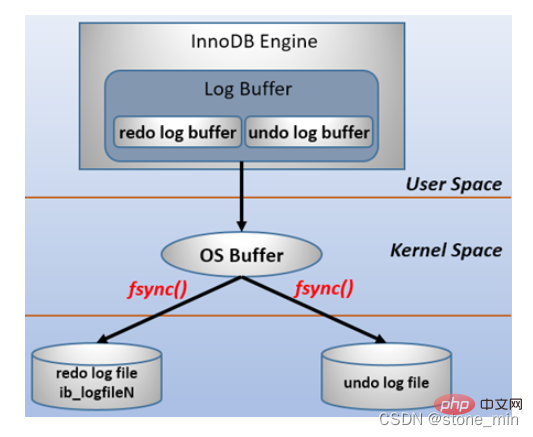
mysql support Three timings for writing redo log buffer to redo log file can be configured through the innodb_flush_log_at_trx_commit parameter. The meaning of each parameter value is as follows:
| Parameter value | Meaning |
|---|---|
| 0 (delayed writing) | When the transaction is submitted, the log in the redo log buffer will not be written to the os buffer, but every second Write to the os buffer and call fsync() to write to the redo log file. That is to say, when set to 0, data is written to the disk (approximately) every second. When the system crashes, 1 second of data will be lost. |
| 1 (real-time writing, real-time brushing) | Every time a transaction is submitted, the log in the redo log buffer will be written to the os buffer and fsync() will be called to flush to redo log file. This method will not lose any data even if the system crashes, but because each submission is written to the disk, the IO performance is poor. |
| 2 (real-time writing, delayed brushing) | Each submission is only written to the os buffer, and then fsync() is called every second to write the data in the os buffer The log is written to the redo log file. |

redo log recording format
Redolog adopts a fixed size and cyclic writing format. When the redolog is full, it will be written from the beginning again. Why is it designed like this?
The main purpose of redo log is to reduce the requirement for data page flushing. Redolog records the modifications on the data page, but when the data page is also flushed back to the disk, these records become useless. Therefore, when MySQL determines that the previous redolog has expired, the new data will overwrite the invalid data. So how to judge whether it should be covered? 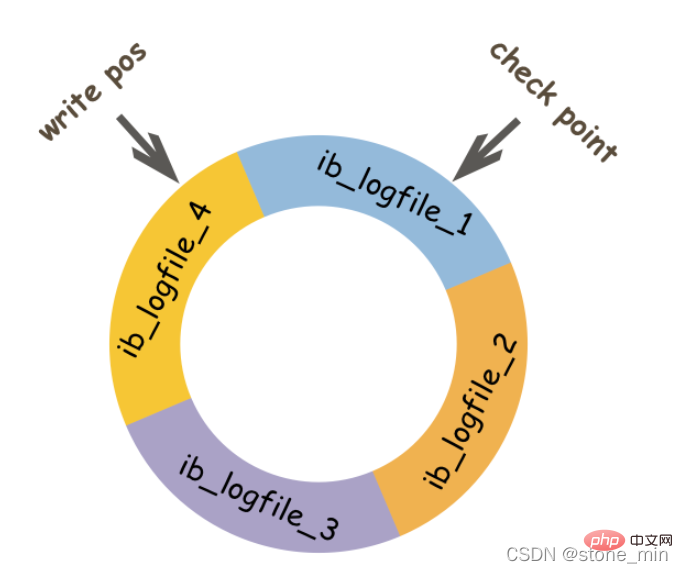
The above picture is a schematic diagram of redo log file. write pos represents the log sequence number LSN (log sequence number) currently recorded by redolog. When the data page has been flushed back to the disk, the LSN in the redo log file will be updated, indicating that the data before this LSN has been written to the disk. This LSN is the check point. The part between write pos and check point is the spare part of redolog, which is used to record new records; the part between check point and write pos is the modified part of the data page that has been recorded by redolog, but the data page has not been flushed back to the disk at this time. part. When the write pos catches up with the check point, it will first push the check point forward, vacate the position, and then record a new log.
When starting innodb, regardless of whether it was shut down normally or abnormally last time, recovery operations will always be performed. During recovery, the LSN in the data page will be checked first. If this LSN is smaller than the LSN in the redolog, that is, the write pos position, it means that the unfinished operations on the data page are recorded in the redolog, and then it will start from the nearest check point. , start synchronizing data.
Is it possible that the LSN in the data page is greater than the LSN in the redolog? The answer is of course possible. When this happens, the part beyond the redolog will not be redone, because this itself means that what has been done does not need to be redone.
The difference between redo log and binlog
| binlog | ||
|---|---|---|
| The size of the redo log is fixed. | Binlog can set the size of each binlog file through the configuration parameter max_binlog_size. | |
| The redo log is implemented by the InnoDB engine layer, and not all engines have it. | Binlog is implemented by the Server layer. All engines can use binlog logs | |
| redo log is recorded in a loop writing method. When writing to the end, it will return to the beginning and write the log in a loop. | binlog is recorded by appending. When the file size is larger than the given value, subsequent logs will be recorded to new files | |
| redo log is suitable for crash recovery (crash-safe) | binlog is suitable for master-slave replication and data recovery |
The above is the detailed content of Completely master MySQL's three major logs: binlog, redo log and undo log. For more information, please follow other related articles on the PHP Chinese website!

Hot AI Tools

Undresser.AI Undress
AI-powered app for creating realistic nude photos

AI Clothes Remover
Online AI tool for removing clothes from photos.

Undress AI Tool
Undress images for free

Clothoff.io
AI clothes remover

Video Face Swap
Swap faces in any video effortlessly with our completely free AI face swap tool!

Hot Article

Hot Tools

Notepad++7.3.1
Easy-to-use and free code editor

SublimeText3 Chinese version
Chinese version, very easy to use

Zend Studio 13.0.1
Powerful PHP integrated development environment

Dreamweaver CS6
Visual web development tools

SublimeText3 Mac version
God-level code editing software (SublimeText3)

Hot Topics
 1667
1667
 14
14
 1426
1426
 52
52
 1328
1328
 25
25
 1273
1273
 29
29
 1255
1255
 24
24
 Laravel Introduction Example
Apr 18, 2025 pm 12:45 PM
Laravel Introduction Example
Apr 18, 2025 pm 12:45 PM
Laravel is a PHP framework for easy building of web applications. It provides a range of powerful features including: Installation: Install the Laravel CLI globally with Composer and create applications in the project directory. Routing: Define the relationship between the URL and the handler in routes/web.php. View: Create a view in resources/views to render the application's interface. Database Integration: Provides out-of-the-box integration with databases such as MySQL and uses migration to create and modify tables. Model and Controller: The model represents the database entity and the controller processes HTTP requests.
 MySQL and phpMyAdmin: Core Features and Functions
Apr 22, 2025 am 12:12 AM
MySQL and phpMyAdmin: Core Features and Functions
Apr 22, 2025 am 12:12 AM
MySQL and phpMyAdmin are powerful database management tools. 1) MySQL is used to create databases and tables, and to execute DML and SQL queries. 2) phpMyAdmin provides an intuitive interface for database management, table structure management, data operations and user permission management.
 MySQL vs. Other Programming Languages: A Comparison
Apr 19, 2025 am 12:22 AM
MySQL vs. Other Programming Languages: A Comparison
Apr 19, 2025 am 12:22 AM
Compared with other programming languages, MySQL is mainly used to store and manage data, while other languages such as Python, Java, and C are used for logical processing and application development. MySQL is known for its high performance, scalability and cross-platform support, suitable for data management needs, while other languages have advantages in their respective fields such as data analytics, enterprise applications, and system programming.
 Solve database connection problem: a practical case of using minii/db library
Apr 18, 2025 am 07:09 AM
Solve database connection problem: a practical case of using minii/db library
Apr 18, 2025 am 07:09 AM
I encountered a tricky problem when developing a small application: the need to quickly integrate a lightweight database operation library. After trying multiple libraries, I found that they either have too much functionality or are not very compatible. Eventually, I found minii/db, a simplified version based on Yii2 that solved my problem perfectly.
 Laravel framework installation method
Apr 18, 2025 pm 12:54 PM
Laravel framework installation method
Apr 18, 2025 pm 12:54 PM
Article summary: This article provides detailed step-by-step instructions to guide readers on how to easily install the Laravel framework. Laravel is a powerful PHP framework that speeds up the development process of web applications. This tutorial covers the installation process from system requirements to configuring databases and setting up routing. By following these steps, readers can quickly and efficiently lay a solid foundation for their Laravel project.
 Solve MySQL mode problem: The experience of using the TheliaMySQLModesChecker module
Apr 18, 2025 am 08:42 AM
Solve MySQL mode problem: The experience of using the TheliaMySQLModesChecker module
Apr 18, 2025 am 08:42 AM
When developing an e-commerce website using Thelia, I encountered a tricky problem: MySQL mode is not set properly, causing some features to not function properly. After some exploration, I found a module called TheliaMySQLModesChecker, which is able to automatically fix the MySQL pattern required by Thelia, completely solving my troubles.
 Explain the purpose of foreign keys in MySQL.
Apr 25, 2025 am 12:17 AM
Explain the purpose of foreign keys in MySQL.
Apr 25, 2025 am 12:17 AM
In MySQL, the function of foreign keys is to establish the relationship between tables and ensure the consistency and integrity of the data. Foreign keys maintain the effectiveness of data through reference integrity checks and cascading operations. Pay attention to performance optimization and avoid common errors when using them.
 Compare and contrast MySQL and MariaDB.
Apr 26, 2025 am 12:08 AM
Compare and contrast MySQL and MariaDB.
Apr 26, 2025 am 12:08 AM
The main difference between MySQL and MariaDB is performance, functionality and license: 1. MySQL is developed by Oracle, and MariaDB is its fork. 2. MariaDB may perform better in high load environments. 3.MariaDB provides more storage engines and functions. 4.MySQL adopts a dual license, and MariaDB is completely open source. The existing infrastructure, performance requirements, functional requirements and license costs should be taken into account when choosing.





